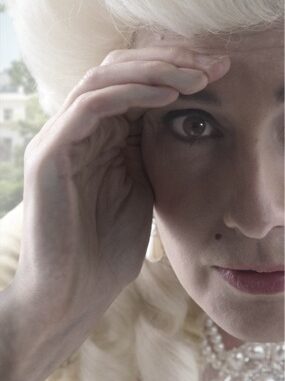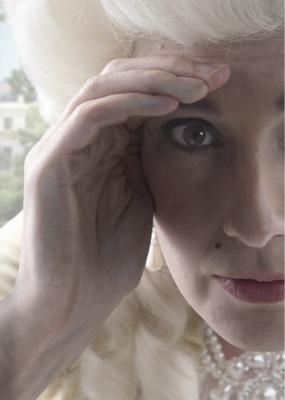
‘I want visitors to consider what it feels like to be scrutinised.’
Our world of celebrity obsession isn’t new. People were pushing up against the Sphinx to glimpse Pharaoh’s new head-dress, crowds lined the Via Appia to see Septimius Severus’ latest toga praetexta. In the early 1800s it was the turn of an especially dissolute member of the British royals to attract attention. In a whirl of debauchery George, Prince of Wales, was doing his best to get as fat as possible as quickly as possible. He had chosen Brighton for his vain and extravagant pleasures. His new Pavilion – influenced by rumours of rather than experience of the East – faced a public road and had large windows through which he and his guests could not only see out, but could also be watched.
This sensation of being observed that George had enjoyed in his youth started to pall as he obesified and aged. Peepers is a new artwork in the music room of the Brighton Pavilion which replicates this phenomenon. Created by Maisie Broadhead, one of the winners of the Jerwood Open Makers 2013, the installation has replaced the room’s five large windows with giant photos on back-lit light boxes. A graduate of Brighton College of Art and the RCA, Broadhead spent ten months creating the very site-specific work. There are also iPads screening her earlier work, made in 2012 for a show at the National Gallery.

After walking around the Pavilion looking at objects and architecture as in any other museum, the visitor enters the music room and immediately feels like one of the items on display. Characters in Georgian dress peer through the windows, their giant size filling the window spaces. One might be George’s father George III (mad, lost the colonies, etc). Mistresses and a daughter add to the intense inward gaze, whilst lurking at the back of the crowd is a younger man, maybe Cruickshank or one of the other cartoonists who brutally criticised George’s lifestyle.
Both inside and out the Pavilion is an absurd confection. The music room itself features dragons clinging to chandeliers, serpents climbing up curtains and a dragon carpet. ‘I can imagine for many eyes it must have symbolised the gulf between their lives and the lives of royalty,’ Broadhead said about the Pavilion and to be noticed amongst the Eastern madness, palm trees and peacocks her work was going to have be large and bold. Peepers is well-integrated into the room, which cannot have been easy to achieve as none of the opulent interior could be altered or touched.
Like George himself, Broadhead’s images are of an extravagant size. Trees and blue skies behind the humans suggest all would be well if wasn’t for those pesky people.Though they are in period dress the girl’s boater looks too modern and suggests similar contemporary concerns with privacy. People still peer in on the rich and famous though we now look twice-removed – through the high powered lens of the paparazzi and the pages of celeb magazines. Extreme wasteful wealth and poverty still coexist. There are less beauty spots painted onto cheeks today, and the media is massier, but otherwise the symbiotic relationships between fame-seekers and the public continues. Like George the fame-hungry usually realise enough is enough but find the public interest that they have built up hard to switch off.
The sympathies of Peepers are with the watched, particularly the Prince – a man who ran up £650,000 of debts and had them paid off by Parliament. He lived in a luxury the peepers couldn’t possibly imagine and he could have reduced the painful scrutiny by living less wastefully. Or just by drawing the curtains. If they hadn’t got serpents climbing up them.

Leave a Reply